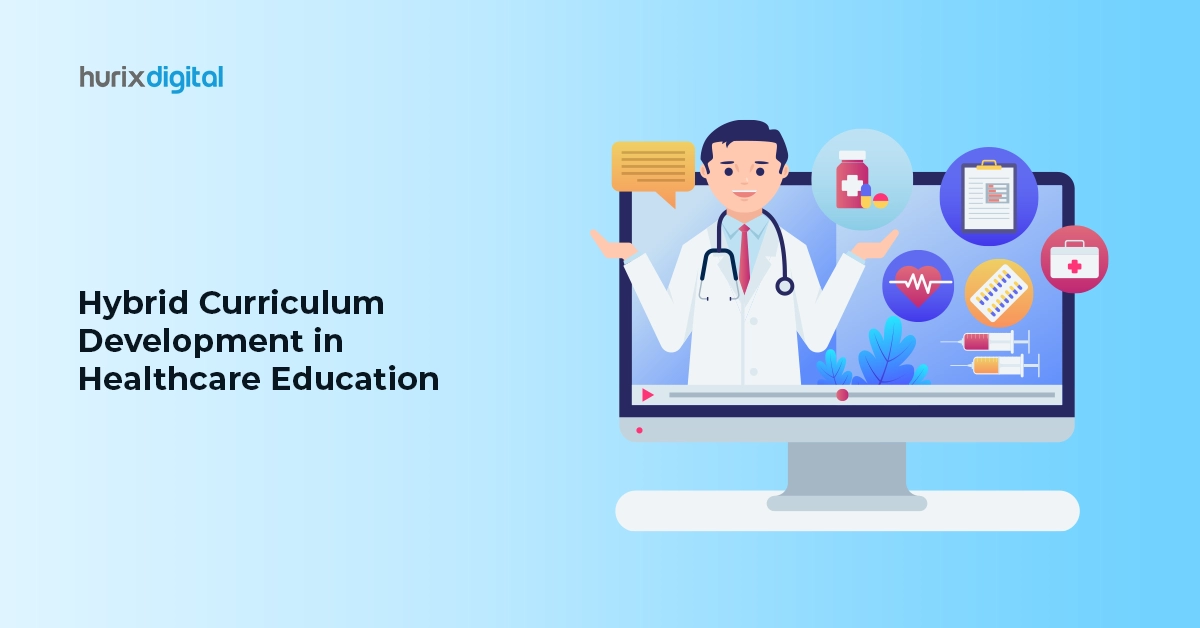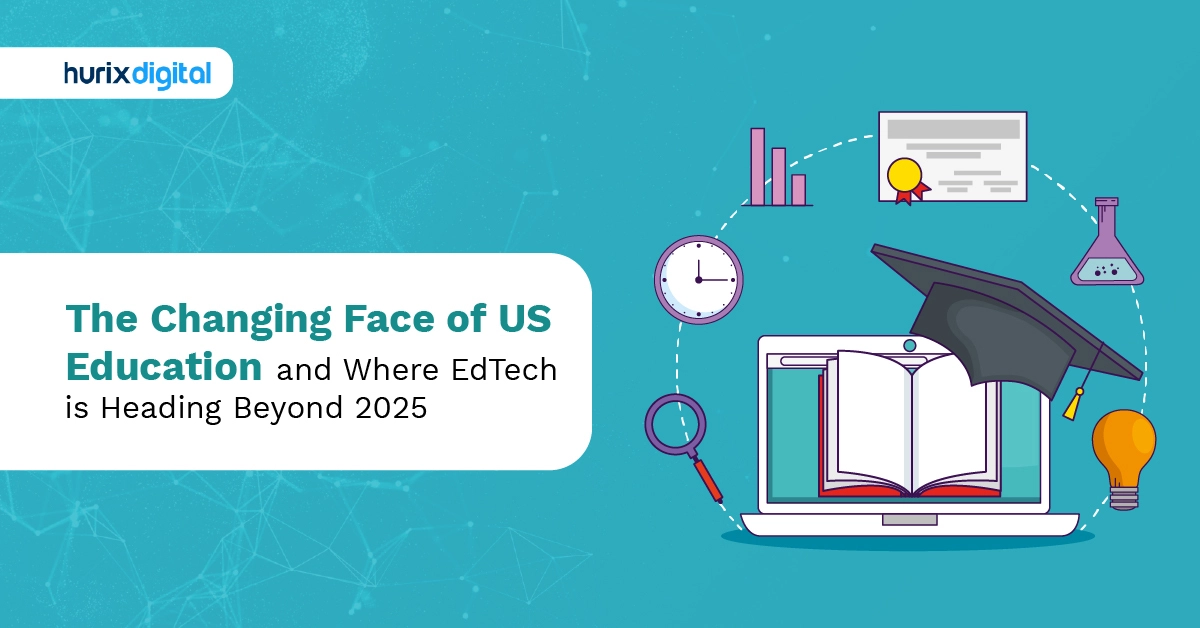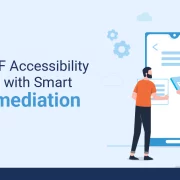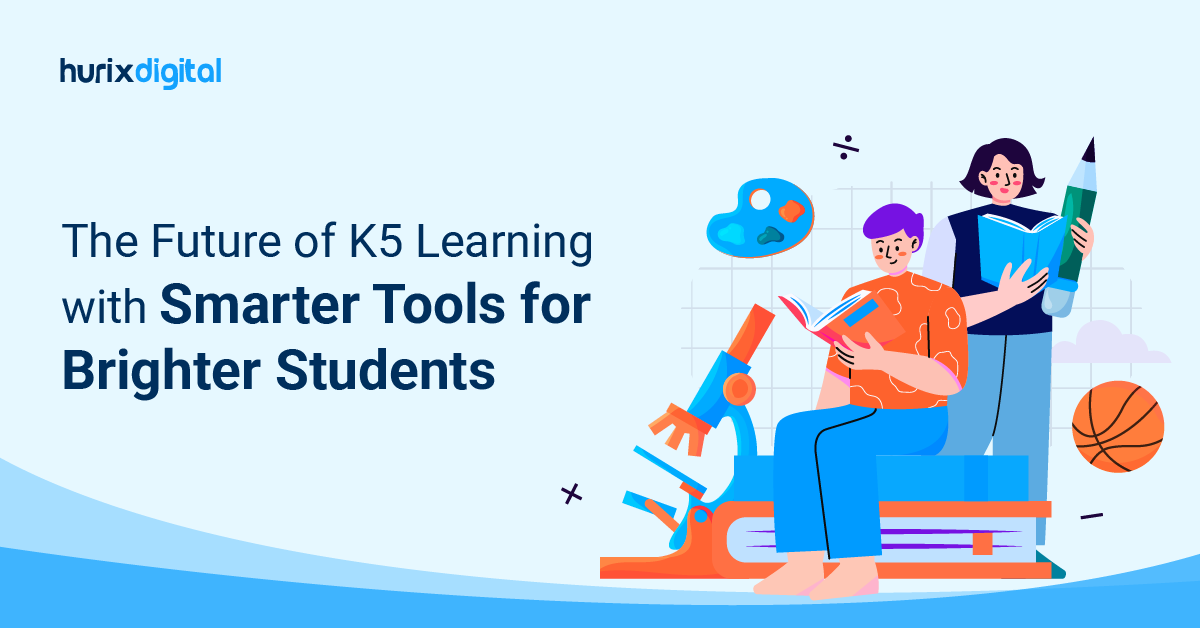
The Future of K5 Learning with Smarter Tools for Brighter Students
K5 education is the period of formal education from Kindergarten to Grade 5. The future of education is being drastically revolutionized owing to tech-based solutions that maximize the cognitive, creative, and logical skills of children in their growing years.
From the advent of AI to the introduction of augmented reality for experiential learning, technology is impacting the way children learn and develop in more ways than you can imagine. This article outlines the impacts, ongoing trends, benefits, and transformations of technological solutions for K5 education. Read on to find out more!
Table of Contents:
- 5 Ways of Retaining the Attention of K5 Students
- Incorporate Critical Thinking in the Classroom for K5 Students
- How Technology Has Changed K5 Education Positively?
- Use of Interactive Whiteboards Creates an Engaging Learning Experience
- Gamification Improves Student Motivation And Focus Level
- Virtual Reality and Augmented Reality Ensures Immersive Learning
- Incorporating Blended Learning Systems Enhances Retention Rate
- Wearable Technology Provides Children with Real-Time Feedback
- How Does AI Impact Math and Science Education?
- 6 Ways AI-Powered Learning is Helping K5 Students Conquer Math and Science
- What is Social-Emotional Learning (SEL)?
- Why is Social-Emotional Learning Important?
- Latest Trends of the SEL Market Size
- How to Implement Social-Emotional Learning in the Classroom?
- Takeaway
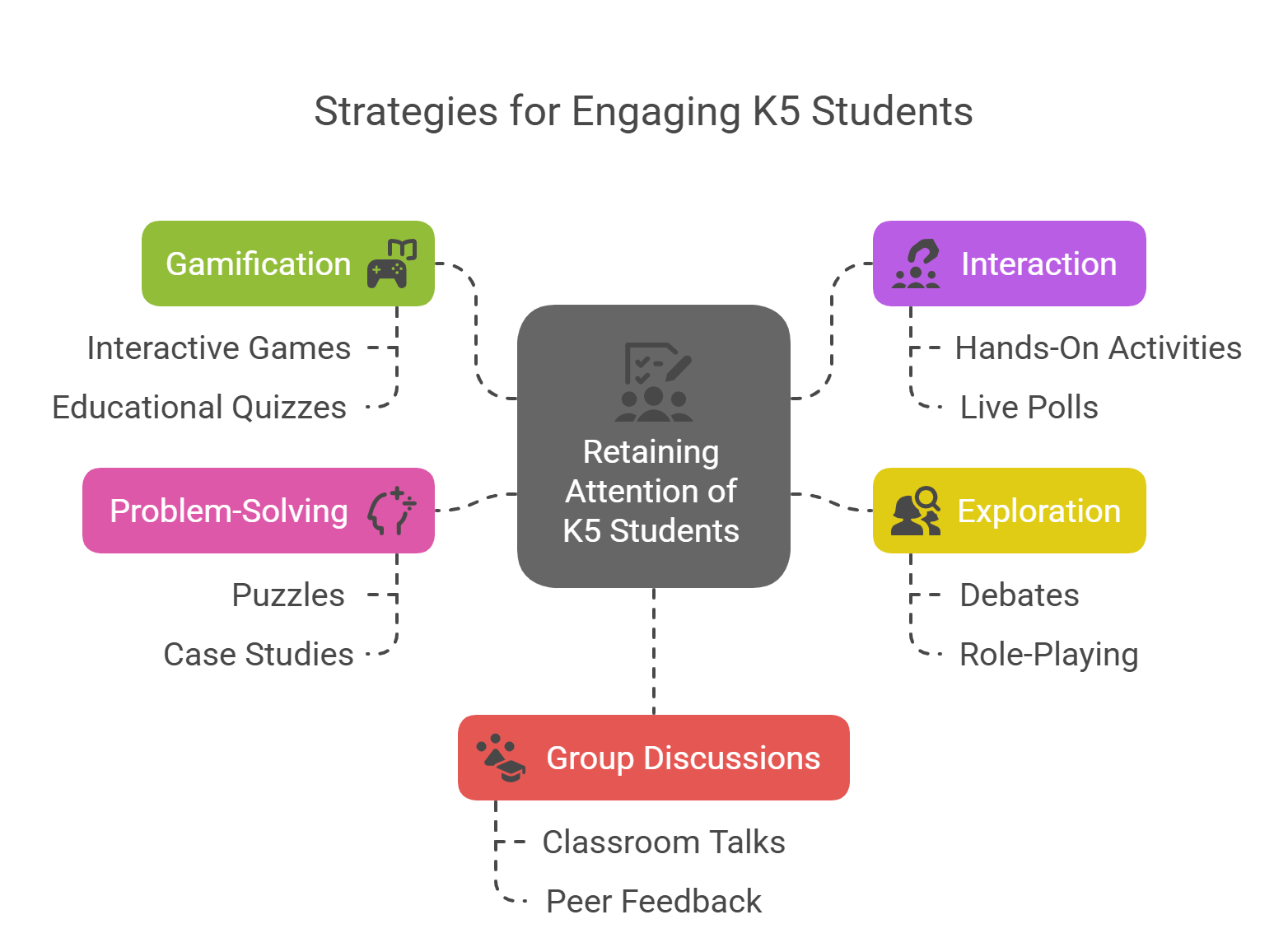
5 Ways of Retaining the Attention of K5 Students
One of the biggest challenges of elementary education is maintaining students’ attention. Educators cannot deliver positive learning outcomes if their students do not feel engaged. This is especially true when it comes to teaching critical thinking. Let’s dive in further on how to promote critical thinking in the classroom:
1. Use Gamification to Make Concepts Tangible
Gamification is a valuable tool for teaching children complex concepts by introducing game-like elements such as scenario games, puzzles, and scavenger hunts. This approach encourages critical thinking, allowing students to apply their knowledge within practical game-based scenarios. Plus, with collaborative games like scavenger hunts, students learn to take input from multiple students to conclude.
In essence, gamification empowers educators to effectively assess and enhance students’ problem-solving and collaboration skills, which are integral to critical thinking.
Furthermore, you can actively involve children in learning by rewarding how they approach and solve problems. Reward systems, badges, and leaderboards are engaging approaches suitable for K5 students. This method effectively fosters curiosity, encourages intrinsic motivation, and cultivates skills like self-regulation and persistence.
2. Provide Interaction Possibilities
Interaction in the form of Q&A sessions is the core foundation of agile learning. It breeds reasoning and an aptitude for questioning the ‘how’ and ‘why’ of an element wherever possible.
Asking questions is one of the greatest methods for getting kids talking and thinking, so try to ask questions that require more than a simple yes or no response whenever possible. Make connections between concepts by asking, “What do you think?” or “How do you feel?” and then follow up with open-ended inquiries.
This approach prepares students to actively reflect on scenarios, develop a keen understanding of their environment, and think independently. They can understand concepts better when they’re broken down and simplified with an illustrative format showcased through questions like: ‘Give an example’ or ‘Do you have an alternate opinion?’
3. Enable Kids to Explore Various Points of View
Use various instructional techniques, such as discussions, reading aloud, demonstrations, and hands-on activities, to give students a sense of how to develop a mindset that encourages critical thinking outside of the classroom.
Use songs and jingles in enactments and re-enactments as an example. You can also set up a play with diverse characters, enabling students to relate to characters different from themselves. In this way, you can encourage children to explore diverse views rather than merely telling them how to perceive a subject.
4. Challenge Their Problem-Solving Skills
You can evaluate the sharpness and focus of your students through playing out real-time scenarios in the form of debates or discussions. State a problem or question that aligns with the grade you teach.
- Are teachers or the Internet better for your learning?
- Should students wear school uniforms?
Provide students the chance to decide based on reason instead of emotion or perhaps evaluate how they use their emotions when arguing for or against them. Offer students the option to solve issues on their own, without knowing the solution in advance, by using trial-and-error techniques.
5. Encourage Students to Participate in Group Discussions
When students are allowed to work in groups, they can discuss ideas with other people, form opinions, and learn from each other. This will enable them to use their critical thinking skills to ask the ‘right’ questions and develop creative solutions. Engaging in discussions enhances students’ collaboration skills and ability to express themselves, fostering a deeper understanding of themselves and the topic at hand.
Incorporate Critical Thinking in the Classroom for K5 Students
Critical thinking skills are crucial at any age but become much more important throughout the first few years of school. The ability to assess information, analyze it, and draw connections between ideas is essential for K5 because it aids in developing critical thinking skills.
Beyond the five methods discussed above, here are some additional tips to help young students improve critical thinking:
- Give students access to materials like books, magazines, or comics to encourage them to critically consider the information they consume to help them develop the ability to assess information independently.
- Encourage students to identify inconsistencies in books or tales they read aloud in class by posing questions such as, “What do you notice about this story?” or “Is there anything wrong with this picture?” These questions enable students to think deeply about the information they consume beyond face value.
- Connect coursework to real circumstances to facilitate active and practical learning. For instance, while teaching math, ask students how they may use this idea in everyday activities like grocery shopping or family vacations.
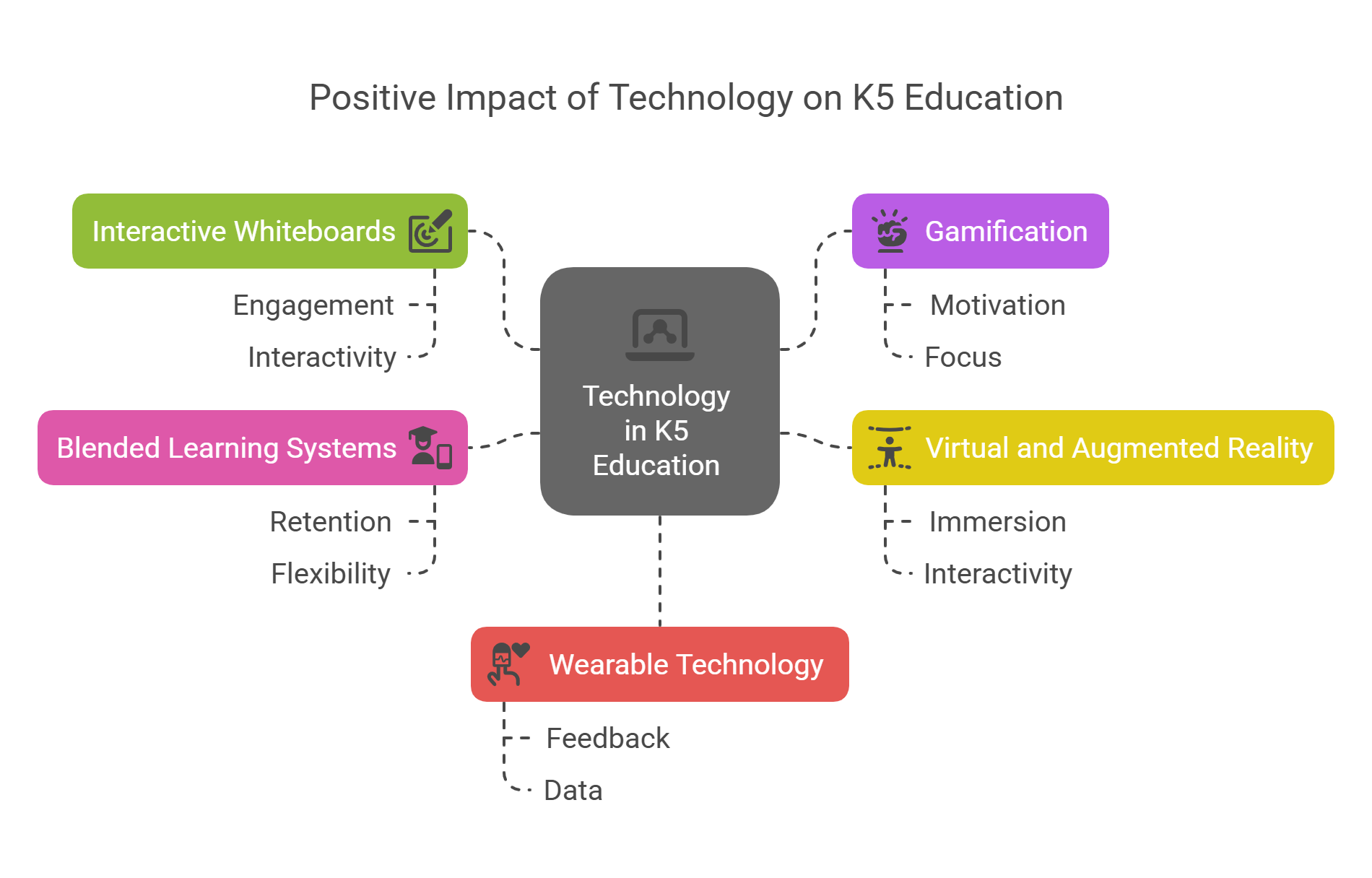
How Technology Has Changed K5 Education Positively?
While various eLearning solutions are paving the way for a new era of creative K5 education, there is more in store for a promising future.
Technology has transformed education, rendering it more interesting, effective, and accessible for both students and teachers thanks to innovations like the following-
1. Use of Interactive Whiteboards Creates an Engaging Learning Experience
Due to their capacity to improve student learning, smart boards are becoming increasingly prevalent in classrooms. These interactive whiteboards allow teachers to present educational material and involve students in practical learning exercises.
Teachers can enhance conventional teaching techniques by using interactive multimedia tools, photos, and videos to develop an exciting atmosphere for K5 education.
Teachers can add visual aids to their classes and offer interactive learning opportunities using smart boards. They also give students a place to work together on group projects and demonstrations.
Students can interact with the subject matter more experientially and perceptibly if they can move objects around on the board.
2. Gamification Improves Student Motivation And Focus Level
Gamification can drastically alter educational experiences by using games’ potential. Gamified learning improves participation, motivation, and retention by combining game features, prizes, and obstacles.
Game-based learning content or blended learning material is more relevant to actual situations than traditional learning materials. Because gamified content is easily customizable, teachers may give students a unique learning path.
Instilling a sense of responsibility in the learners through even minor components like personalized game avatars or personal leaderboards inspires them to perform better during their educational journey.
3. Virtual Reality and Augmented Reality Ensures Immersive Learning
Virtual Reality (VR) is an excellent pedagogical tool for K5 education. Kids can use VR headsets to engage in immersive learning that additionally stimulates their sense of hearing, sight, and more.
Experiencing real-life scenarios in 3D models increases the retention rate and helps develop children’s cognitive skills, such as pattern recognition, information processing, and attention to detail.
The application of augmented reality (AR) engages children’s minds and promotes conversation. Children are more inclined to recall what they have learned when they are emotionally driven.
For example, story-reading AR apps can generate high-level interest in young minds, further improving their vocab and comprehension skills.
Through immersive digital encounters, the application of augmented reality in education creates new eLearning opportunities.
For instance, a teacher can offer the students access to an augmented reality (AR) solar system model that allows them to discover space and planets while being still seated in the classroom.
4. Incorporating Blended Learning Systems Enhances Retention Rate
Blended learning is a way of teaching that integrates traditional classroom approaches with online learning resources and interactive possibilities.
Every learner has a unique learning style and method. Some kids prefer to study just from text, while others favor incredibly engaging classes.
The main advantage of blended learning in K5 education is that it can create customized, intended, and distinct learning routes.
Blended learning allows for the creation of classes that are built on materials particularly tailored to the needs of each learner. Teachers can take advantage of this chance to learn how much the pupils have previously learned and how much more they need to acquire to advance.
Learning can continue outside of the traditional classroom setting. Students can access a wide range of eLearning information, games, quizzes, exercises, and e-books from the comfort of their own homes.
5. Wearable Technology Provides Children with Real-Time Feedback
New advancements in wearable technology have changed the teaching and learning processes, enabling students to engage with knowledge in an engaged, independent, and productive manner.
Wearable technology can encourage children’s creativity and ingenuity as an educational tool while facilitating more straightforward and organic interactions between them and their environment.
Keygloves, virtual reality (VR), smartwatches, e-textiles, Google Glass, and headsets are just a few instances of wearable technology that can be employed in the classroom and beyond.
These tools can help students improve their teamwork, interaction, problem-solving abilities, and virtual learning skills.
How Does AI Impact Math and Science Education?
Integrating AI tools like ChatGPT in math education helps teachers foster students’ number sense by applying math concepts to real-life situations. AI tools’ ability to generate rich math problems encourages critical reasoning, deep mathematical thinking, and problem-solving skills among K5 students.
AI platforms like augmented reality (AR) and virtual reality (VR) are increasingly used in K5 digital classrooms to simulate real-world scenarios and environments. By bringing abstract science concepts to life, AI tools create immersive learning experiences that spark students’ curiosity.
They also enable students to interact with complex concepts hands-on, deepening their grasp of the subject matter. Let’s explore how AI is supporting K5 students.
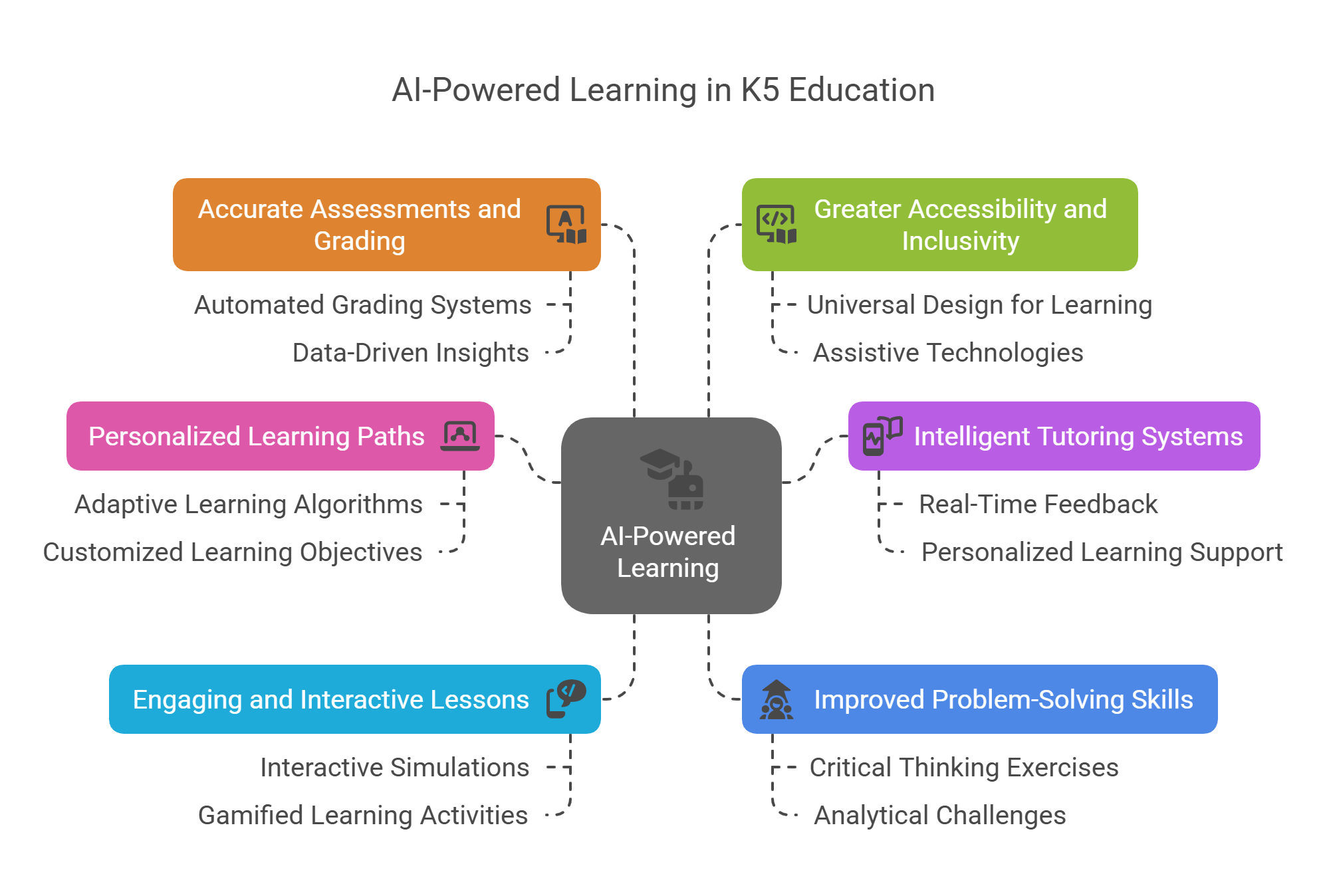
6 Ways AI-Powered Learning is Helping K5 Students Conquer Math and Science
We live in a digital age, and technology is pivotal in our everyday lives. The goal of modern education is to make students ‘AI Ready’.
Here are six ways AI enhances Math and Science learning for 21st Century Digital Learners.
1. Personalized Learning Paths
Over the last decade, teacher shortages have spread, and learner variability has increased. NAEP results revealed that across 26 districts in 2022, 18-77% of 4th-grade students performed below NAEP Basic in mathematics. The large city average was 36%.
As the student population becomes more diverse, AI systems help execute the Sisyphean task of “meeting all students where they are’.
With the help of AI, educators can personalize learning for each student, allowing them to progress at their own pace. Adaptive learning platforms powered by AI algorithms can identify students’ skills and weaknesses, helping them focus on areas that require additional attention.
For instance, McGraw Hill’s ALEKS, a digital supplemental science and math program for grades 3-12, leverages AI to enhance student learning outcomes. It accurately assesses students’ knowledge and determines their readiness to learn more complex concepts.
2. Intelligent Tutoring Systems
Just like learner diversity, the amount of available data has grown exponentially. Analyzing oceans of data to provide personalized support and inform instruction requires exceptional efforts.
Here’s when AI-powered assistants come in handy. By analyzing student performance data, AI-created intelligent tutoring systems provide students with personalized feedback and guidance to navigate their learning journey.
They also help educators gather, interpret, and respond to data to address students’ needs. These systems adapt to student’s learning styles and preferences, assisting them in real-time and helping them overcome challenges and build confidence.
3. Engaging and Interactive Lessons
AI technologies like AR and VR can significantly improve math and science education student engagement. For instance, students can visualize complex functions or explore three-dimensional geometric shapes in a dynamic virtual space.
These visually engaging representations of abstract mathematical concepts make math more tangible and easier to grasp. The best part is that AI facilitates gamified learning.
AI-powered learning platforms incorporate gamification elements like badges, leaderboards, and rewards, transforming math into an engaging and enjoyable activity.
AR and VR also help students better understand intricate and abstract scientific concepts that may be challenging to comprehend or visualize.
AI tools like virtual labs allow students to conduct experiments in a controlled and safe environment. This gives them more interactive and hands-on experience that traditional classrooms cannot offer.
4. Improved Problem-Solving Skills
Math is inherently linked to problem-solving, and AI plays a pivotal role in honing students’ problem-solving skills. AI-driven tutoring platforms provide individualized guidance and support.
These platforms use adaptive algorithms to analyze student responses, determine misconceptions, and provide targeted feedback and hints to enhance problem-solving abilities.
Students can engage with diverse AI-generated problem sets encompassing various difficulty levels and real-world applications.
These systems help turn students into self-reliant learners and proficient problem solvers by providing step-by-step guidance and real-time feedback.
5. Accurate Assessments and Grading
To err is human.
Educators who create or evaluate standardized assessments can inadvertently make errors, affecting student’s education. On the contrary, AI programs consistently demonstrate remarkable accuracy in practical applications.
For instance, McGraw Hill’s Actively Learn, a digital supplementary curriculum platform designed for grades 3-12 in science, social studies, and English Language Arts (ELA), leverages AI to grade short-answer responses.
By eliminating biases in grading, AI ensures students are assessed based on their actual understanding and knowledge. Timely, valuable comments from human instructors and AI help students return on the right track.
6. Greater Accessibility and Inclusivity
Ensuring fair access to AI technologies is critical to fostering a more inclusive educational environment. Thanks to AI, students with learning disabilities or those unable to attend in-person classes can now access educational materials.
With the growth of AI-powered tutoring tools, students worldwide can now access high-quality education regardless of their financial background, location, or other barriers.
What is Social-Emotional Learning (SEL)?
Social-emotional learning (SEL) is the process of fostering interpersonal abilities necessary for thriving in school, the workplace, and life.
The CASEL (Collaborative for Academic, Social, and Emotional Learning) framework identifies SEL as consisting of five interconnected areas of abilities:
- Self-awareness: The capacity to name, recognize, and comprehend one’s own feelings and thoughts, as well as how they affect behavior.
- Social awareness: The capacity to adopt various viewpoints, as well as compassion and regard for others.
- Responsible decision-making: The capacity to make morally righteous decisions regarding one’s activities and interactions with others.
- Self-management: The capacity to control one’s feelings and emotions, cope with stress, and establish personal objectives.
- Relationship skills: The ability to create and sustain strong, dependable bonds.
As students progress through their academic careers, SEL helps them understand, regulate, and accept their own emotions as well as the emotions of their classmates.
SEL is considered crucial for teachers to comprehend and practice in their classrooms to make learning effortless for students.
Why is Social-Emotional Learning Important in K5 Education?
People who possess high socio-emotional abilities are better able to handle daily problems and reap academic, career, and social benefits.
SEL provides a framework for beneficial, long-term benefits for children, like:
- Innovative problem-solving
- Disciplined behavior
- Social awareness
- Impulse management
- Emotion regulation
- Time management
The approaches and delivery techniques used in social-emotional learning curricula might differ significantly.
While some programs emphasize character development, others concentrate on fostering fundamental skills like social awareness. A few are focused on games, while others are project-based.
Hence, while planning SEL curricula for K5 education, different learning styles of kids must be included.
Latest Trends of the SEL Market Size
At a predicted CAGR of 24.5%, the extent of the global market for social and emotional learning is expected to increase from $1.13 billion in 2022 to $5.21 billion by 2029.
The growing competition and demand for remote learning post-pandemic have led to a surge in the requirement for SEL tools to balance students’ mental well-being.
The wide range of benefits of social-emotional learning has led to the collaboration of key industry players with schools to enhance children’s skill development in K5 education.
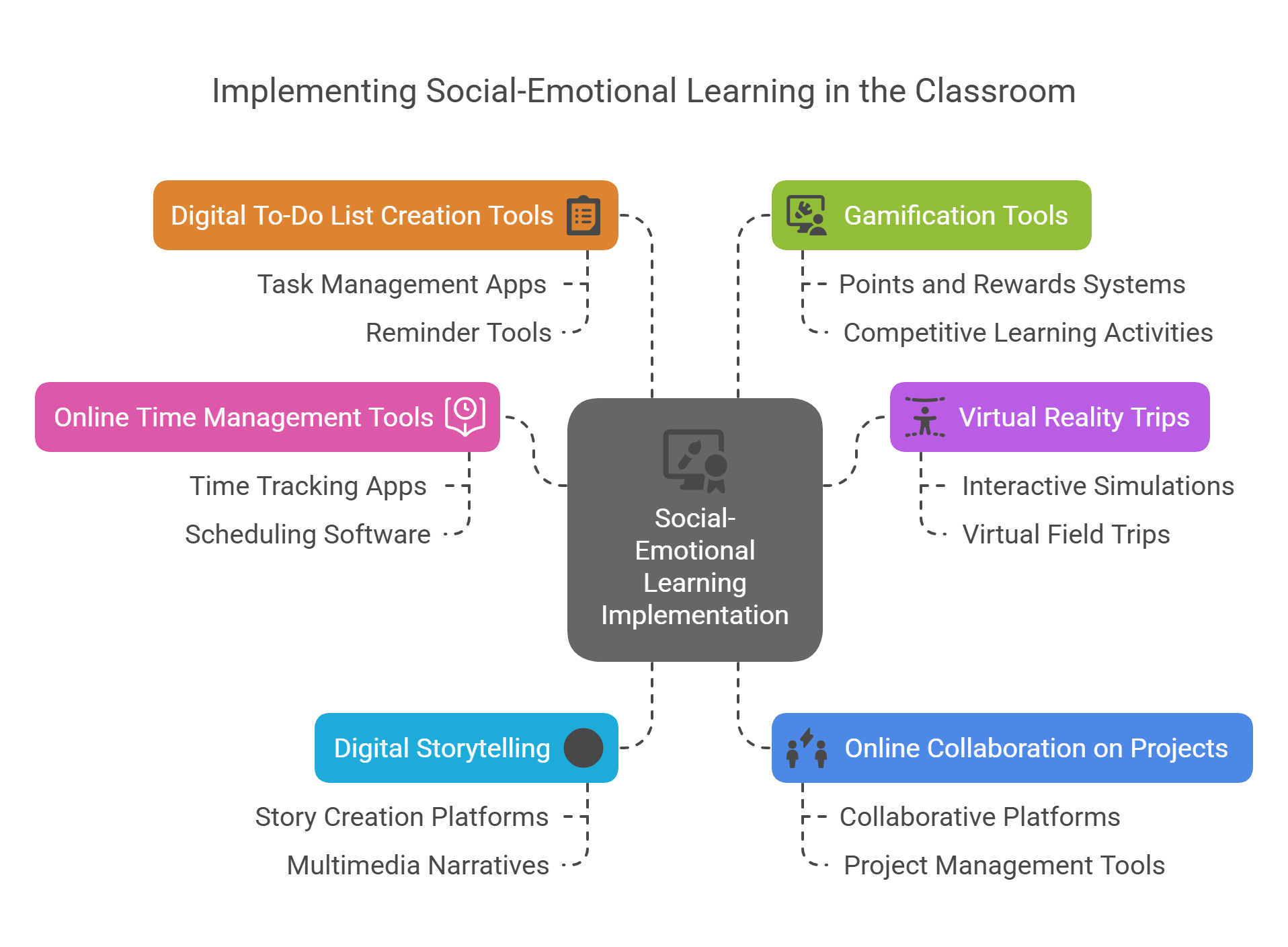
How to Implement Social-Emotional Learning in the Classroom?
Choosing the right Ed-Tech tools to imbibe SEL in K5 education is of paramount importance. SEL greatly impacts the all-round development of the personality of kids in their growing years.
Educators can integrate the below-listed eLearning tools in their classrooms to implement social-emotional learning activities in varied ways.
1. Online Time Management Tools
You are practicing time management when you schedule and organize your time for various tasks.
However, doing so comes with several difficulties. Children need to practice time management skills as part of their social-emotional learning programs.
Students can learn to better manage their time through activities such as online time management tools, digital planning objectives exercises, and virtual mindfulness practices.
Online time management tools, such as task time trackers, timesheets, productivity calendars, etc., can help users develop self-management skills in ways that suit their individual interests.
2. Virtual Reality Trips
Relationships improve when children learn about each other and their shared and unique characteristics. Students can use resources in their science and language programs to go on virtual field trips.
Students can be virtually transported to various locations across the world and given a close-up tour using VR tours. Exposing pupils to a variety of cultures, customs, and ways of life can help them develop a greater understanding of people from different backgrounds and foster social consciousness.
3. Digital Storytelling
Educators can instruct students to curate stories that raise social consciousness using digital storytelling tools. Students can also use software to make demonstrations and short films that emphasize social concerns and social justice.
These tools help raise social awareness by inspiring students to reflect objectively on social issues and assess their role in bringing about positive change.
4. Online Collaboration on Projects
Both students and teachers need a place where they feel at ease asking for assistance, assisting, and cooperating with others.
Teachers can assist by motivating students to work together on online projects utilizing online resources. Using online collaboration tools can foster the development of interpersonal and cooperation skills.
Students benefit from building social-emotional learning in the classroom while they collaborate online. For instance, as students collaborate on a project, they learn from one another and gain experience engaging online, which also translates to the classroom setting.
5. Digital To-Do List Creation Tools
Social-emotional learning examples include self-management skills. Online goal-setting encourages managing oneself by empowering learners to take charge of their education.
Students attaining K5 education can also utilize digital tools to construct reminders, due dates, and to-do lists. These resources can assist students in setting objectives, visualizing the tasks they need to do, and learning better time management techniques.
6. Gamification Tools
SEL in the classroom can be effectively promoted via educational games that follow the social-emotional learning curriculum.
Teachers may foster empathy, teamwork, and emotional intelligence by carefully choosing games that serve a goal, leading post-game conversations with students, and incorporating reflective exercises.
For instance, social-emotional learning activities in video games can be seen in historical simulations that demand that players adopt a variety of viewpoints on historical events.
In other instances, SEL is promoted by instructing students to cooperate in teams to complete the aims and goals of different educational activities.
Takeaway
Technology is playing a bigger role in education since it engages students through efficient instruction and a wide range of online programs.
The learning process for both students and teachers is changing dramatically as a result of its broad adoption. Tech-based eLearning solutions are helping children develop their cognitive skills in their growing years.
If you’re seeking technology solutions to improve K5 education, Get in contact with Hurix Digital. Hurix Digital’s eLearning solutions aim to provide students with the finest eLearning solutions.
To fulfill the specific requirements of each business or student, we offer unique learning pathways and material that can be customized according to your choice and requirements.

Senior Vice President
A Business Development professional with >20 years of experience with strong capability to sell new solutions and develop new markets from scratch. New Market Entry Specialist with experience of working in two of the largest emerging markets – China & India. Also covered other key markets in APAC, US, EU & ME. Exceptional experience of conceptualizing, ideating and selling new learning technologies like VR AR, etc. across multiple industry verticals.


